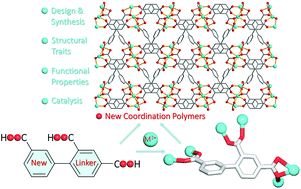Coordination polymers from an unexplored biphenyl-tricarboxylate linker: hydrothermal synthesis, structural traits and catalytic cyanosilylation†
Abstract
A novel biphenyl-tricarboxylic acid, 3,2′,4′-biphenyl-tricarboxylic acid (H3bta), was used as a versatile linker for preparing a new series of nickel(II), zinc(II), and cadmium(II) coordination polymers (CPs) and complexes, formulated as {[Cd(μ-Hbta)(2,2′-bipy)(H2O)]·3H2O}n (1), {[Ni(μ-Hbta)(4,4′-bipy)(H2O)3]·H2O}n (2), [M2(μ-Hbta)2(4,4′-bipy)2(H2O)2]·2H2O (M = Zn (3) and Cd (4)), {[Cd2(μ4-bta)(μ-Cl)(phen)2]·2H2O}n (5), {[Zn2(μ3-bta)(2,2′-bipy)2(H2O)3][Zn(μ-bta)(2,2′-bipy)(H2O)]·3H2O} (6), {[Cd3(μ4-bta)2(2,2′-bipy)3]·4H2O}n (7), {[Zn3(μ3-bta)2(H2biim)2(μ-H2biim)(H2O)2]·2H2O}n (8), and [Zn3(μ6-bta)2(py)2]n (9). These coordination compounds were hydrothermally assembled from the metal(II) chlorides, H3bta as a principal building block and N-donor ancillary ligands as crystallization mediators (i.e., 2,2′-bipyridine, 2,2′-bipy; 4,4′-bipyridine, 4,4′-bipy; 1,10-phenanthroline, phen; 2,2′-biimidazole, H2biim; or pyridine, py). All the synthesized products 1–9 were characterized by standard solid-state methods including elemental analysis, IR spectroscopy, thermogravimetric analysis (TGA), powder X-ray diffraction (PXRD) and single-crystal X-ray diffraction. The structures of 1–9 range from 0D dimers (3 and 4) to 1D coordination polymers (1, 2, 5, and 6) and 2D metal–organic layers (7–9). Such a diversity of structures is explained by the differences in metal(II) centers, deprotonation levels of H3bta, and crystallization mediators. From a topological perspective, the obtained structures include 2C1 chains (in 1, 2, and 6), pcu H-bonded nets (in 3 and 4), SP 1-periodic nets (in 5), and 4,5L51 (in 7) and hcb (in 8) layers. For compounds 1–9, luminescence properties were also evaluated. Besides, the catalytic behavior of the obtained products was screened in the cyanosilylation of benzaldehydes with trimethylsilyl cyanide to give cyanohydrin products under mild conditions, including an optimization of various reaction parameters and an investigation of the substrate scope. Among the tested compounds, 3 acts as the most efficient and recyclable heterogeneous catalyst with up to 96% product yields. By presenting the unique examples of coordination compounds derived from H3bta, this study introduces its use as a new tricarboxylate linker for assembling functional coordination polymers and metal complexes.



 Please wait while we load your content...
Please wait while we load your content...